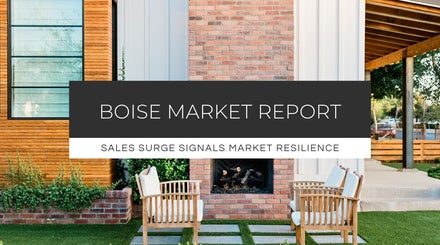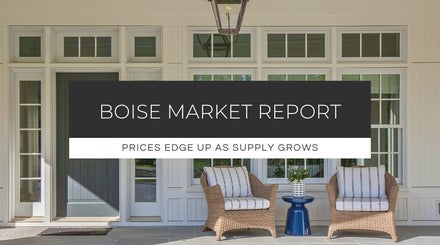
Across the Treasure Valley are signs that the housing shortage is starting to ease as the supply of homes for sale rises to pre-pandemic levels.
Even as prices continue to move higher, appreciation rates (the annual change in home prices) are beginning to normalize, bringing much-needed balance to the Boise market.
Ada County’s median sale price rose 12.81% from a year earlier, and Canyon County’s rose by 4.95%.
Year-over-year price gains are down significantly from the 30%+ appreciation we saw in 2021, offering buyers some relief. Overall, it's a move to a much healthier market, putting us closer to the Treasure Valley's 5-6% long-term price appreciation average.
At the beginning of July, the total number of homes for sale rose to 2,081 and 1,152 in Ada County and Canyon County, respectively, higher than this time in 2020 and 2021. However, 1 in 4 of those homes are yet to be started or unfinished new construction. While the supply is notably higher than last year, it’s not as high as it looks.
Additionally, homes sold at the second-fastest pace for any June on record. In both counties, median days on market were just 10. The takeaway: Demand remains but not at any price.
While we are not yet in a truly balanced market, buyers have not had this many choices since the pandemic began.
Ada County’s median sales price for new and existing houses rose $67,230 over the prior year to $592,180. While Canyon County’s increased $20,990 to $444,990.
Price gains slowed across the Treasure Valley in June:
- Boise’s median home price finished the month at $555,511, increasing $55,511 (11.11%) from 12 months ago.
- Meridian ended June at $585,000, an increase of $48,500 (9.04%) from the year prior.
- The city of Eagle, where monthly price changes tend to be more volatile, eked out a small gain of $9,000 (1.06%) to end the month at $858,000.
- Single-family home prices in Nampa, one of the area’s lowest-cost markets, rose by $26,500 (6.36%) to $441,500.
- In one of the Treasure Valley’s smallest communities, Star, the cost of the typical home rose to $627,500, a $93,650 (17.54%) jump.

Despite price gains coming back down to earth and a growing pool of options, many buyers, particularly first-time purchasers, are struggling with quickly growing mortgage payments.
Rapidly rising mortgage rates are doing precisely what the Federal Reserve intended–reduce demand. Higher interest rates for financing an education and purchasing cars and homes add to the cost of borrowing, making purchases less affordable, less desirable, and for some, unattainable.
Interest rates have been rising for a year, yet most of the gains have come in the last few months. People adjust to a slow and steady rise in interest rates, but when rates surge from 3% to 5.5% in six months, it creates a substantial shock to the system.
If you were on the edge of qualifying for a loan in March and couldn’t find a home, the rise in mortgage rates has likely priced you out.
Builders on Edge as Buyers Are Forced to Walk Away From Contracts
Buyers that had contracted to purchase new construction homes in previous months have faced rising mortgage costs that, in some cases, have made the homes unaffordable.
Potential homeowners who agreed to purchase when rates were lower find that they can no longer afford the same home with today's interest rates.
Their original monthly payments were calculated based on lower rates than are available today. Even a 1% increase in mortgage rates can lead to a monthly payment hundreds of dollars a month higher.
Some buyers absorb the extra cost by increasing the down payment or buying down the rate (paying more in upfront fees for a smaller monthly payment). Others are forced to walk away.
Depending on the contract terms, buyers are typically on the hook for 5% to 10% of the purchase price–money they won't get back if they are unwilling or unable to complete the transaction.
Rate locks would have helped avoid some of these issues, but many buyers (and frankly, their agents) didn’t know to ask, and builders, who should have insisted on it, have grown complacent over the last two years.
Overpricing Is Leading to More Price Cuts as the Market Finds Its Footing
Expect to see an increase in price cuts as sellers adjust to the new normal.
Sellers have been hearing about the red-hot market for years. Some consider it the perfect opportunity to shoot for the stars when pricing their property for sale.
Even though buyers are still motivated, it doesn't mean they will pay anything. Also, with more alternatives, it's much easier for buyers to steer clear of overpriced listings.
As you would expect, some overpriced houses are sitting unsold and eventually receiving price cuts.
After two years of anything-goes pricing, sellers now have to try to find the market again. This tends to happen every time there is a change in appreciation trends. We saw it at the beginning of 2021 when sellers were underpricing by tens of thousands of dollars.
It’s not only resale sellers. The builders slashing prices the quickest are the same ones who raised prices the most in the past year.
You might wonder how prices and price cuts can rise simultaneously. Because sellers are not cutting prices from where they were a year ago–the prices they are cutting are 20%-25% higher than a year ago.
Sellers could be more aggressive when there were four or five buyers for every listing than when there are one or two. Expect to see more price adjustments as sellers look for the pricing sweet spot (and adjust to reality) in the market.
--
Price reductions aren’t as good of a market health metric as they used to be.
In the past, sellers would take their time to carefully review comparable past sales before setting a listing price that was as close to market value as possible.
With the extreme market of the past few years, sellers have taken more of a swing for the fences, let’s set a neighborhood record kind of price. “Besides, if we don’t immediately get a bidding war, we can just quickly cut the price.”
Even though data shows that such a strategy almost always backfires, ultimately leading to a lower sale price, it is still the plan for many sellers.
Additionally, some of the more prominent builders in the area are using "airline-style" dynamic pricing, a strategy that involves continuously moving prices up and down to maximize sales.
Expect Returning Seasonality to Create a More Level Playing Field
Between June 2020 and June 2021, Ada County set 13 consecutive price records. As home prices marched higher, the typical seasonality we see in the Treasure Valley went out the window.
The home listing pattern that otherwise occurs every year like clockwork started to work its way back in last fall.
History shows that the supply of homes for sale rises throughout the first eight months of the year before peaking in September. After Labor Day, the number of new listings declines substantially, reducing the supply of homes for sale through the end of the year, at which point the process repeats itself.
Regardless of other factors, seasonality is back to stay. Inventory will continue to rise over the next few months, offering more choices for buyers and slowing appreciation to a more balanced rate. Right now, we are seeing a shift from 30%+ to single-digit home price growth.
If you plan to sell in the second half of this year, the best advice is to price your property at market value and not above it.
Boise Real Estate Market Summary for June 2022
- Median list price - $560,000 (up 14.05%)
- Median sold price - $555,511 (up 11.10%)
- Price per square foot - $328 (up 10.07%)
- Total home sales - 316 (down 86)
- Median days on market - 7 days (up 2 days)
- Available homes for sale - 2.28 month supply (up 1.65)
- 30-year mortgage rates - 5.52% (up 2.54)
Boise Metro Housing Markets by Area
- Ada County - $592,090
- Eagle - $858,000
- Garden City - $525,000
- Kuna - $469,995
- Meridian - $585,000
- Star - $627,500
- Canyon County - $444,990
- Caldwell - $410,000
- Middleton - $533,195
- Nampa - $441,500
More From Our Blog
Information in this We Know Boise market report was obtained from the Intermountain MLS (IMLS) on July 7th, 2022. Deemed reliable but not guaranteed. City data refers to single-family homes on less than one acre, while county data includes homesites of all sizes. Current inventory is calculated on a twelve-month rolling average. Combining existing homes for sale with new construction is the best way to gauge current home prices and Boise housing market trends. New house prices are much more volatile and can create unreliable comparisons, particularly on a month-to-month basis.
Posted by Lisa Kohl on






Leave A Comment